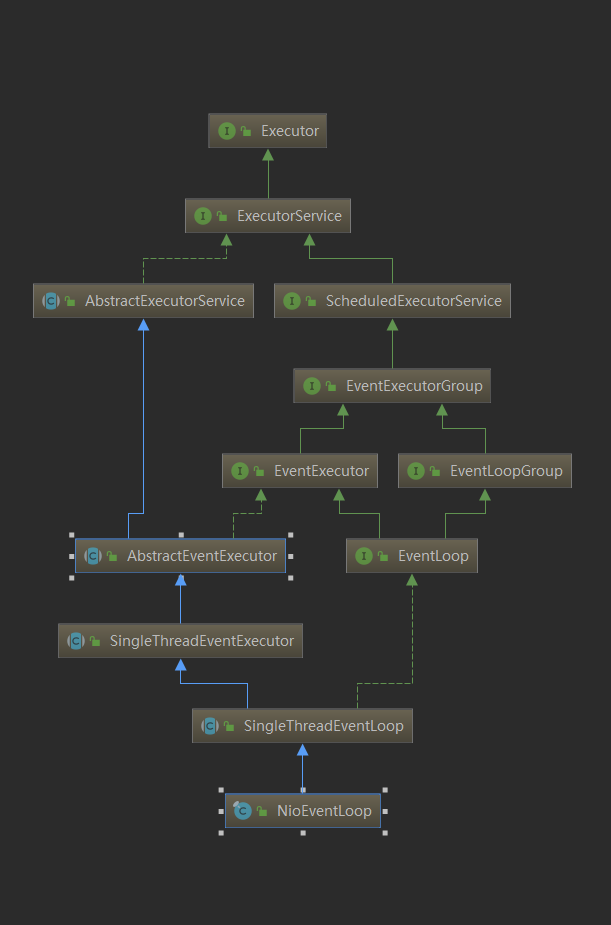netty(三)---NioEventLoop分析
问题 :
- NioEventLoop 作用到底是什么?是在哪里用到的?
- NioEventLoop 和我们开头创建的 ServerBootstrap 和 EventLoopGroup 是什么关系 ?
- NioEventLoop 和 NioChannel 怎么传递的(按合理,一个channel应该分配一个NioEventLoop)
- NioEventLoop 工作原理
概述
要知道 NioEventLoop 就必须从 EventLoopGroup 说起,以下是它们的类结构图。
 我们在分析 netty 服务端处理的过程中,有一个 createChannel() 的过程,然后调用 group().next() 方法返回一个 NioEventLoop ,剩下的东西就交给这个 NioEventLoop 来处理了,实际中 EventLoopGroup 包含这一个 NioEventLoop 数组,它们是执行处理的实施者。
我们在分析 netty 服务端处理的过程中,有一个 createChannel() 的过程,然后调用 group().next() 方法返回一个 NioEventLoop ,剩下的东西就交给这个 NioEventLoop 来处理了,实际中 EventLoopGroup 包含这一个 NioEventLoop 数组,它们是执行处理的实施者。
源码分析
EventLoopGroup 的父类 MultithreadEventLoopGroup分析
public abstract class MultithreadEventLoopGroup extends MultithreadEventExecutorGroup implements EventLoopGroup {
private static final InternalLogger logger = InternalLoggerFactory.getInstance(MultithreadEventLoopGroup.class);
private static final int DEFAULT_EVENT_LOOP_THREADS;
//默认EventLoopThreads处理线程数
static {
DEFAULT_EVENT_LOOP_THREADS = Math.max(1, SystemPropertyUtil.getInt(
"io.netty.eventLoopThreads", Runtime.getRuntime().availableProcessors() * 2));
if (logger.isDebugEnabled()) {
logger.debug("-Dio.netty.eventLoopThreads: {}", DEFAULT_EVENT_LOOP_THREADS);
}
}
/**
* @see {@link MultithreadEventExecutorGroup#MultithreadEventExecutorGroup(int, Executor, Object...)}
*/
protected MultithreadEventLoopGroup(int nThreads, Executor executor, Object... args) {
super(nThreads == 0 ? DEFAULT_EVENT_LOOP_THREADS : nThreads, executor, args);
}
/**
* @see {@link MultithreadEventExecutorGroup#MultithreadEventExecutorGroup(int, ThreadFactory, Object...)}
*/
protected MultithreadEventLoopGroup(int nThreads, ThreadFactory threadFactory, Object... args) {
super(nThreads == 0 ? DEFAULT_EVENT_LOOP_THREADS : nThreads, threadFactory, args);
}
@Override
protected ThreadFactory newDefaultThreadFactory() {
return new DefaultThreadFactory(getClass(), Thread.MAX_PRIORITY);
}
@Override
public EventLoop next() {
return (EventLoop) super.next();
}
@Override
protected abstract EventLoop newChild(Executor executor, Object... args) throws Exception;
}
MultithreadEventExecutorGroup 类
public abstract class MultithreadEventExecutorGroup extends AbstractEventExecutorGroup {
//接受到任务,交给children 执行
private final EventExecutor[] children;
private final Set<EventExecutor> readonlyChildren;
private final AtomicInteger childIndex = new AtomicInteger();
private final AtomicInteger terminatedChildren = new AtomicInteger();
private final Promise<?> terminationFuture = new DefaultPromise(GlobalEventExecutor.INSTANCE);
/**
* Create a new instance.
*
* @param nThreads the number of threads that will be used by this instance.
* @param threadFactory the ThreadFactory to use, or {@code null} if the default should be used.
* @param args arguments which will passed to each {@link #newChild(Executor, Object...)} call
*/
protected MultithreadEventExecutorGroup(int nThreads, ThreadFactory threadFactory, Object... args) {
this(nThreads, threadFactory == null ? null : new ThreadPerTaskExecutor(threadFactory), args);
}
/**
* Create a new instance.
*
* @param nThreads the number of threads that will be used by this instance.
* @param executor the Executor to use, or {@code null} if the default should be used.
* @param args arguments which will passed to each {@link #newChild(Executor, Object...)} call
*/
protected MultithreadEventExecutorGroup(int nThreads, Executor executor, Object... args) {
if (nThreads <= 0) {
throw new IllegalArgumentException(String.format("nThreads: %d (expected: > 0)", nThreads));
}
if (executor == null) {
executor = new ThreadPerTaskExecutor(newDefaultThreadFactory());
}
children = new EventExecutor[nThreads];
for (int i = 0; i < nThreads; i ++) {
boolean success = false;
try {
children[i] = newChild(executor, args);
success = true;
} catch (Exception e) {
// TODO: Think about if this is a good exception type
throw new IllegalStateException("failed to create a child event loop", e);
} finally {
if (!success) {
for (int j = 0; j < i; j ++) {
children[j].shutdownGracefully();
}
for (int j = 0; j < i; j ++) {
EventExecutor e = children[j];
try {
while (!e.isTerminated()) {
e.awaitTermination(Integer.MAX_VALUE, TimeUnit.SECONDS);
}
} catch (InterruptedException interrupted) {
Thread.currentThread().interrupt();
break;
}
}
}
}
}
final FutureListener<Object> terminationListener = new FutureListener<Object>() {
@Override
public void operationComplete(Future<Object> future) throws Exception {
if (terminatedChildren.incrementAndGet() == children.length) {
terminationFuture.setSuccess(null);
}
}
};
for (EventExecutor e: children) {
e.terminationFuture().addListener(terminationListener);
}
Set<EventExecutor> childrenSet = new LinkedHashSet<EventExecutor>(children.length);
Collections.addAll(childrenSet, children);
readonlyChildren = Collections.unmodifiableSet(childrenSet);
}
protected ThreadFactory newDefaultThreadFactory() {
return new DefaultThreadFactory(getClass());
}
@Override
public EventExecutor next() {
return children[Math.abs(childIndex.getAndIncrement() % children.length)];
}
...
可以看到构造方法,就是创建多个 child (真正处理的执行者)。其中 newChild 交给子类实现,我们看一下NioEventLoopGroup newChild 的实现。
@Override
protected EventLoop newChild(Executor executor, Object... args) throws Exception {
return new NioEventLoop(this, executor, (SelectorProvider) args[0]);
}
至此,我们摸清了最终“干活”的人就是 NioEventLoop 。
参考资料
无
netty(三)---NioEventLoop分析的更多相关文章
- Netty源码分析之NioEventLoop(三)—NioEventLoop的执行
前面两篇文章Netty源码分析之NioEventLoop(一)—NioEventLoop的创建与Netty源码分析之NioEventLoop(二)—NioEventLoop的启动中我们对NioEven ...
- Netty源码分析第2章(NioEventLoop)---->第1节: NioEventLoopGroup之创建线程执行器
Netty源码分析第二章: NioEventLoop 概述: 通过上一章的学习, 我们了解了Server启动的大致流程, 有很多组件与模块并没有细讲, 从这个章开始, 我们开始详细剖析netty的各个 ...
- Netty源码分析第2章(NioEventLoop)---->第3节: 初始化线程选择器
Netty源码分析第二章:NioEventLoop 第三节:初始化线程选择器 回到上一小节的MultithreadEventExecutorGroup类的构造方法: protected Multi ...
- Netty源码分析第2章(NioEventLoop)---->第6节: 执行select操作
Netty源码分析第二章: NioEventLoop 第六节: 执行select操作 分析完了selector的创建和优化的过程, 这一小节分析select相关操作 跟到跟到select操作的入口 ...
- Netty源码分析之NioEventLoop(二)—NioEventLoop的启动
上篇文章中我们对Netty中NioEventLoop创建流程与源码进行了跟踪分析.本篇文章中我们接着分析NioEventLoop的启动流程: Netty中会在服务端启动和新连接接入时通过chooser ...
- Netty源码分析第2章(NioEventLoop)---->第2节: NioEventLoopGroup之NioEventLoop的创建
Netty源码分析第二章: NioEventLoop 第二节: NioEventLoopGroup之NioEventLoop的创建 回到上一小节的MultithreadEventExecutorG ...
- Netty源码分析第2章(NioEventLoop)---->第4节: NioEventLoop线程的启动
Netty源码分析第二章: NioEventLoop 第四节: NioEventLoop线程的启动 之前的小节我们学习了NioEventLoop的创建以及线程分配器的初始化, 那么NioEvent ...
- Netty源码分析第2章(NioEventLoop)---->第5节: 优化selector
Netty源码分析第二章: NioEventLoop 第五节: 优化selector 在剖析selector轮询之前, 我们先讲解一下selector的创建过程 回顾之前的小节, 在创建NioEv ...
- Netty源码分析第2章(NioEventLoop)---->第7节: 处理IO事件
Netty源码分析第二章: NioEventLoop 第七节:处理IO事件 上一小节我们了解了执行select()操作的相关逻辑, 这一小节我们继续学习select()之后, 轮询到io事件的相关 ...
随机推荐
- Python之路Day01
一.Python简介 Python的历史 Python 2.4 - November 30, 2004, 同年目前最流行的WEB框架Django 诞生 In November 2014, it was ...
- Wannafly Camp 2020 Day 2C 纳新一百的石子游戏
为什么为了这么个简单题发博客呢? 因为我又因为位运算运算符优先级的问题血了 #include <bits/stdc++.h> using namespace std; #define in ...
- 12c的PDB创建DIRECTORY要注意与PATH_PREFIX的关系(ORA-65254)
在创建PDB过程中如果使用了带PATH_PREFIX的参数,意味着在创建DIRECTORY目录时需要指定相对路径,而不能指定其它绝对路径.来自博客园AskScuti 11g整库作为一个PDB迁移至阿里 ...
- Jarvis OJ - 栈系列部分pwn - Writeup
最近做了Jarvis OJ的一部分pwn题,收获颇丰,现在这里简单记录一下exp,分析过程和思路以后再补上 Tell Me Something 此题与level0类似,请参考level0的writeu ...
- Ubuntu卸载软件Firefox
查找火狐详细内容: dpkg --get-selections |grep firefox 删除 sudo apt-get purge firefox*
- 抽象语法树 Abstract syntax tree
什么是抽象语法树? 在计算机科学中,抽象语法和抽象语法树其实是源代码的抽象语法结构的树状表现形式 在线编辑器 我们常用的浏览器就是通过将js代码转化为抽象语法树来进行下一步的分析等其他操作.所以将js ...
- 用控制台编译和运行,输出HelloWorld
HelloWorld 建立一个Java文件,文件后缀为.java(Hello.java) public class Hello{ public static void main(String[ ...
- [lua]紫猫lua教程-命令宝典-L1-01-07. table表
L1[table]01. table表的定义与赋值 小知识:声明表的例子 xx={}--创建一个空表xx --给这表的元素赋值 test="a" xx[test]="a& ...
- Spring Cloud Netflix Eureka【服务治理】
一.简介 二.使用 一.源码分析
- 每天进步一点点------Allegro PCB
Allegro PCB 1.如何在allegro中取消花焊盘(十字焊盘) set up->design parameter ->shape->edit global dynamic ...
